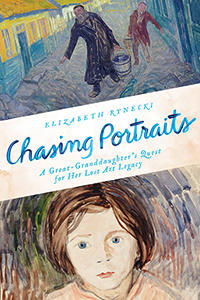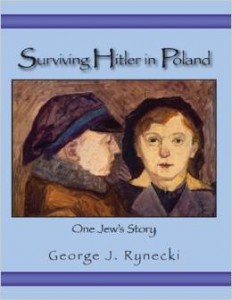| Elizabeth is happy to join your book club, bookstore, library group, or other book discussing friendship group! To book a FREE virtual author visit, email Elizabeth@ElizabethRynecki.com. |
Questions for Chasing Portraits: A Great-Granddaughter’s Quest for Her Lost Art Legacy

WHAT DID YOU know about Holocaust era art restitution issues before reading this book? What surprised you the most about these issues as portrayed in Chasing Portraits?
HOW WAS THE Rynecki family wartime experience the same or different than other World War II accounts that you’ve read?
DO YOU HAVE a favorite Rynecki painting? Is there one described in the book that you wish you could see in person?
A PIVOTAL MOMENT for the author is the discovery of a message her Grandpa George left her in his memoir (page 18). The author talks about the staggering burden of history and legacy upon her shoulders. How did that make you feel? Has someone ever left you a message that inspired you to take on an important project?
AT ITS CORE, the book is about the Rynecki paintings and the author’s quest to rescue her great-grandfather’s lost art legacy. Do you have family heirlooms that you’ve always been curious to know more about? What have you done to research your family’s history? Have you ever worked on your family tree?
ART SPEAKS to us in unique ways. Moshe Rynecki was an ethnographer of sorts, documenting Polish-Jewish life in the interwar years. What role do you think art plays in understanding life for Jews in Poland before the Holocaust? Looking at art more broadly, and at today’s social political issues, what role does art play in better understanding refugees and immigrants?
CHASING PORTRAITS IS a book and a documentary film. What parts of the book do you hope are in the documentary film? Why?
Errata in Chasing Portraits:
Note #1: On page 166 it says, “After lengthy negotiations, in 1988 the Washington Principles were signed by forty-four governments, endorsing eleven principles for handling Nazi-looted art.” The Washington Principles were signed in 1998.
Note #2: On the last page of the color insert there are three photographs. The label for the photograph at the upper right has caused some confusion. The caption says, “Carving held by Shula Eliaz, gift to her family from Perla Rynecki.” The word “held,” is used to indicate Shula Eliaz possesses the carving, not that she is physically holding the carving in the photograph. If you look at the other captions they say, “ABC painting is HELD by XYZ institution (or sometimes individual).” In this Chuck Fishman photograph, Elizabeth Rynecki is the one holding the carving.
Note #3: On page 87 there is a sentence in the top paragraph that reads, in part, “when they finally found their way across the Vistula, Stasia was surprised…” Instead of the name Stasia, it should be Sophie. Stasia is Jerzy’ s wife and was not with Perla when she found the bundle of paintings.
Questions for Surviving Hitler in Poland: One Jew’s Story
The memoir is more of a collection of individual vignettes than a single linear story. How does this impact your understanding of the author’s experiences?
George’s refusal to stay aboard the ship The Battory meant a lost opportunity of escape for himself, but probably is what surely saved his wife and son from certain death. What role does chance play in George’s survival of the Holocaust? What role does choice play?
In the chapter “Thoughts of April 18, 1985,” George reflects upon his writing and says, “There are hundreds of books on the subject. Nevertheless, I am a Jew and I write. I’ll do it till the end of my days. If only for my granddaughter, Elizabeth, to know the truth, and not to be afraid of it. It’s funny how we are not afraid to tell the truth.” Why is George’s granddaughter such a motivating factor in his drive to complete his wartime remembrances? What might motivate you to write your memoirs?
Many stories seem to have a turning point—a point at which the reader understands that the future of the people depends upon that very moment. Is there a turning point in George’s memoir? If so, which event would you define as the turning point? Why?
In the chapter “How Come You Don’t Wear an Armband?,” George writes, “The Church was the worst. I’ll never forgive them. I would rather forgive the Germans. Never the Poles. It’s actually simple.” Why does George have more hatred towards the Polish people than the Germans?
George talks about being able to “forgive but not forget.” Do you think that he ultimately does forgive? Is it possible to achieve this goal? How does one measure this?
Questions for Jewish Life in Poland: The Art of Moshe Rynecki (1881–1943)
Prior to the nineteenth century, painting was not an acceptable trade for Jews—it was considered to trample upon the commandment against creating graven images. Moshe chose not only to paint, but to paint scenes central to the religious life of the Jewish community. Look at paintings such as Simhat Torah and The Reader. What does the composition of the painting say about these moments? What elements do Moshe’s paintings emphasize? How does he use light, color, and texture to create a particular mood? How are these paintings similar? How are they different?
Look at any of the paintings that Moshe Rynecki did prior to the war. What kind of mood does the painting evoke? Now look at a painting that Moshe Rynecki did while inside the Warsaw Ghetto. What kind of mood do these paintings evoke?
Is Moshe Rynecki a “Jewish artist” or an artist who also happens to be Jewish? Is there a difference?
Although Surviving Hitler in Poland: One Jew’s Story is a memoir that stands on its own, it can also be seen as a companion piece to Jewish Life in Poland: The Art of Moshe Rynecki (1881–1943). In what ways does the memoir supplement your understanding and interpretation of the paintings? Are there any particular passages or vignettes that you can identify as giving insight into Moshe’s work as a whole or into certain pieces in particular?
Errata in Jewish life in Poland:
Note #1: in this art book under “Museum Holdings” it states that the National Museum in Krakow has 22 Moshe Rynecki paintings. It is now understood that these 22 paintings are held by the Jewish Historical Institute (ZIH) in Warsaw and that the paintings were loaned to the Krakow museum for the 1989 exhibition “Zydzi – Polscy.”
Note #2: Two pages after the Introduction is a painting with the caption “Paula Rynecki, 1929.” This is, in fact, a painting of Perla Rynecki, Moshe’s wife.

